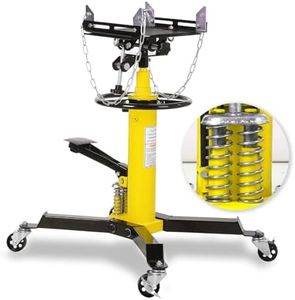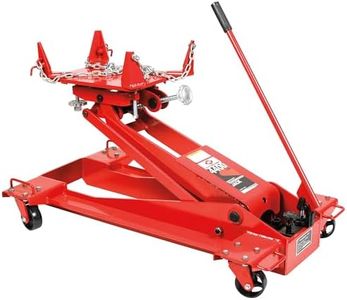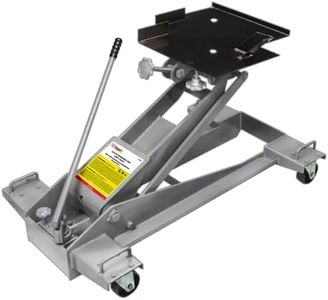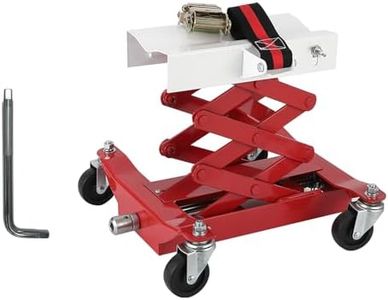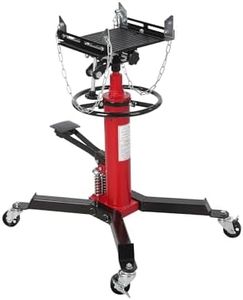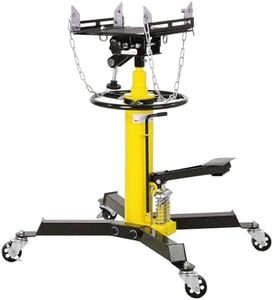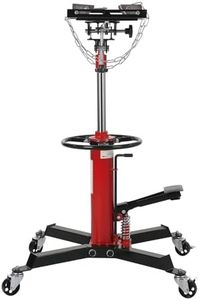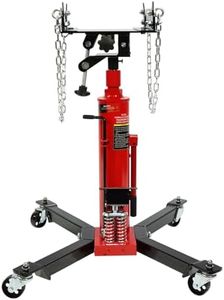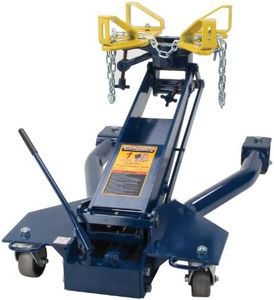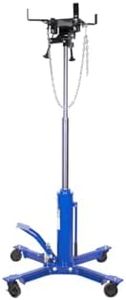10 Best Transmission Jacks 2025 in the United States
Our technology thoroughly searches through the online shopping world, reviewing hundreds of sites. We then process and analyze this information, updating in real-time to bring you the latest top-rated products. This way, you always get the best and most current options available.

Our Top Picks
Winner
OTC TJH10 1,000 LB. Capacity High-Lift Transmission Jack
The OTC TJH10 High-Lift Transmission Jack is a sturdy tool designed for the removal and installation of automobile transmissions. It boasts a weight capacity of 1,000 pounds, making it suitable for a wide range of automotive tasks. The lift range is impressive, extending from a minimum height of 35 inches to a maximum height of 71-5/8 inches, giving users plenty of flexibility.
Stability and safety are well addressed with features like adjustable corner brackets, safety chains, and a tilting head that can move front to back and side to side, making alignment easier during operations. The big, easy-to-grip knobs further enhance usability by simplifying head adjustments. Compliance with ASME PASE-2019 safety standards adds to its reliability.
At 157.7 pounds, it is rather heavy, potentially making it less portable. The maneuverability is aided by 4-inch wheels, but the weight could still pose challenges in a busy workshop setting. This jack operates manually, which might require a bit more effort compared to hydraulic models. This product is well-suited for professional mechanics or serious DIY enthusiasts who need a dependable, high-capacity transmission jack.
AFF Transmission Jack - Low Profile Manual Hydraulic Transmission Floor Jack (Available in Multiple Capacities)
Most important from
34 reviews
The AFF Transmission Jack is a robust tool designed for low-profile applications with a weight capacity of 4,400 pounds. It features a wishbone design that enhances clearance, making it ideal for trucks, buses, and construction equipment. The saddle can tilt, and corner brackets can be adjusted for easy positioning, while the long handle rotates 360° for versatility. Industrial-grade casters ensure smooth transport, and the heavy-duty steel body adds durability.
Safety is prioritized with a built-in overload mechanism and a safety chain to secure the load. With a lift range from 8-1/2 inches to 34 inches, it offers considerable flexibility. This model is manually operated, providing control without the need for an external power source. However, its weight of 330 pounds might make it less maneuverable compared to lighter options.
Its dimensions (49 x 28 x 13 inches) and solid construction are suitable for heavy-duty tasks but could pose storage challenges in smaller workspaces. This transmission jack is best for professionals needing a reliable, high-capacity tool for large vehicle maintenance and installations.
Most important from
34 reviews
OTC 1522A Stinger 2,000 lb. Capacity Heavy-Duty, Low-Lift Transmission Jack for Class 7 & 8 Trucks
Most important from
25 reviews
The OTC 1522A Stinger Transmission Jack is a robust and reliable tool designed for handling heavy-duty tasks, particularly for Class 7 & 8 trucks. With an impressive weight capacity of 2,000 pounds, it is well-suited for heavy transmissions like the Eaton Fuller Roadranger. Its low profile design allows it to fit under trucks with low clearance, making it particularly useful for clutch repair work.
The jack offers a significant lift range, from a minimum height of 6-7/8 inches to a maximum of 35-1/4 inches, ensuring versatility for various tasks. It also features a full 360-degree pump handle rotation, enhancing usability in any position, along with 3.5-inch ball bearing swivel casters for easy maneuverability, which is crucial in tight spaces. In terms of safety, the built-in overload feature prevents overloading, and a safety bypass protects the hydraulic cylinder from damage, offering peace of mind during operation.
The jack is quite heavy at 290 pounds, which may make it challenging to transport without assistance. Despite its weight, the stability and safety features, along with its maneuverability, make it a solid choice for professional use in automotive repair shops. The hydraulic operation of the jack provides smooth and reliable lifting, reducing the physical effort needed compared to manual jacks. Although it might not be the top choice for light-duty tasks or hobbyists, its design and features make it ideal for heavy-duty professional use.
Most important from
25 reviews
Buying Guide for the Best Transmission Jacks
When it comes to picking the right transmission jack, it's important to consider your specific needs and the type of work you'll be doing. Transmission jacks are essential tools for safely and efficiently removing and installing transmissions in vehicles. They come in various types and with different features, so understanding what to look for can help you make the best choice for your situation.FAQ
Most Popular Categories Right Now
